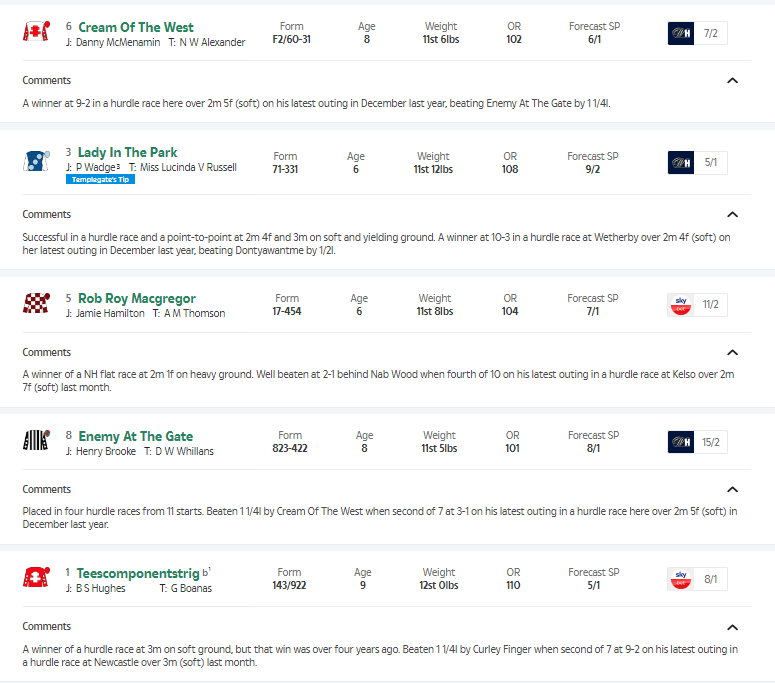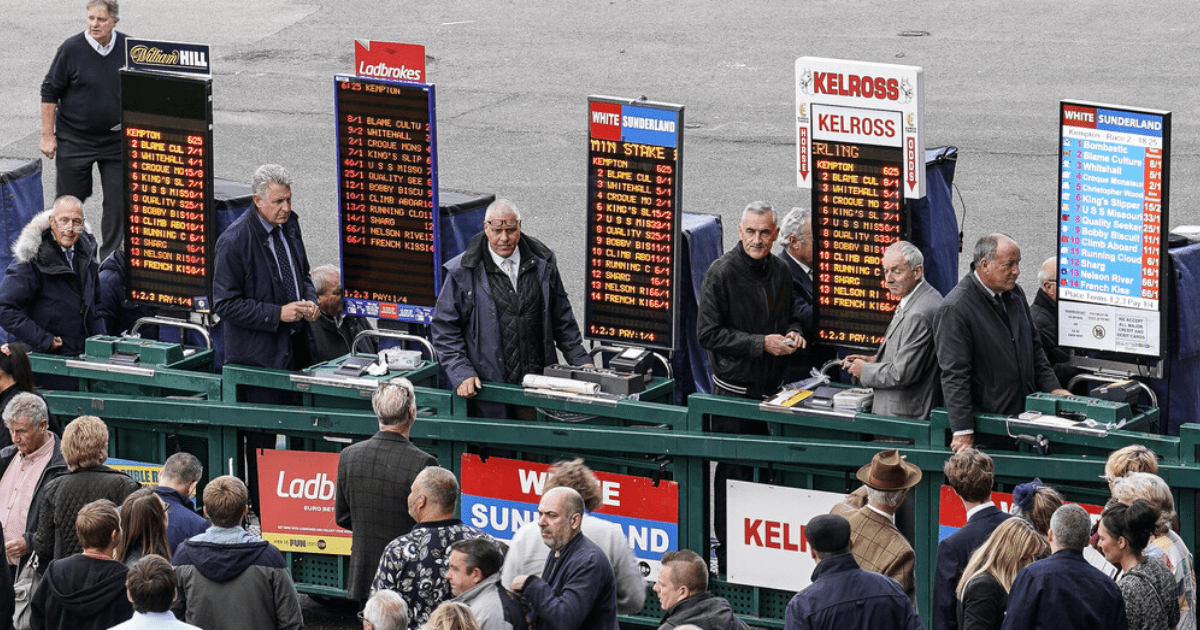Racecards hold the key to determining the potential winner of a horse race. While there can always be surprises, understanding how to navigate the information provided can greatly enhance your chances of making an informed bet. Here, we break down each part of a racecard entry to help you decipher the details. Get ready to boost your horse racing knowledge!
Silks
The silks section of the racecard helps identify which jockey is riding each horse. This information can be crucial when analyzing a race.
Number
The number displayed on a horse's saddle cloth represents its assigned race number. This is an essential detail for tracking and identifying horses during the race.
Horse's Name
The horse's name is pretty self-explanatory. It's important to take note of the name to follow the performance and history of a specific horse.

Headgear
The headgear section of the racecard provides information about the equipment the horse is wearing during the race. T1 indicates that the horse is wearing a tongue tie for the first time, while P represents cheekpieces. These changes in headgear can impact a horse's performance and focus.
Jockey
The jockey section highlights the name of the rider for a particular horse. If there is a number next to the jockey's name, it signifies that they have an allowance due to being a conditional or apprentice rider. This weight allowance can give them a competitive advantage.
Trainer
The trainer section displays the name of the person responsible for training the horse. This information can be useful in assessing the horse's preparation and potential.
Form
The form section provides details about the horse's recent performances, indicating where it has finished in its past few races. A zero (0) signifies that the horse finished outside the top nine. Pay attention to the dash and slash symbols, as they indicate breaks in racing due to the end of the season or injury, respectively. Additionally, letters like UR (unseated rider), F (fell), and RR (refused to race) denote specific incidents during a race.

Age
The age of the horse is a significant factor to consider when analyzing its chances of winning. Younger horses may have more potential for improvement, while older horses may have more experience.
Weight
The weight section reveals the amount a horse will carry in the race, including the jockey. This information is particularly important in handicap races, as it can influence a horse's performance.
Official Rating (OR)
The official rating is a measure of a horse's ability and is assigned by the handicapper. A higher rating indicates a more accomplished horse, while a lower rating suggests a less successful track record.
Forecast SP and Odds
The forecast starting price (SP) estimates the odds of a horse at the beginning of the race. The live odds, displayed on the right side of the racecard, provide the current betting market's perception of a horse's chances.
Additional Information
Aside from the essential details mentioned above, racecards may include additional information such as C, D, and CD, which indicate whether a horse has won at the racecourse (C), over the distance (D), or both (CD). Letters like B, G, CH, etc., are used to describe a horse's color and gender, as well as whether they have been gelded. Lastly, some racecards may include the number of days since a horse's last race, providing insight into its recent activity.
Now that you're armed with the knowledge of how to read a racecard, you can confidently navigate the realm of horse racing and make more informed betting decisions. Remember that understanding the details and trends can greatly enhance your chances of picking a winner. Happy racing!
Frequently Asked Questions
What are the major horse race events?
Triple Crown of Thoroughbred Racing – the Kentucky Derby Stakes, Preakness Stakes and Belmont Stakes – is one of horse racing’s most prestigious events. Dubai World Cup, Prix de l’Arc de Triomphe, Royal Ascot, United Kingdom and Melbourne Cup are all internationally renowned races. These prestigious races attract the best horses, jockeys and trainers in the world.
What is the Triple Crown in horse racing?
Triple Crown is a prestigious award given to a three year old thoroughbred who has won three races of varying importance in the same calendar year. In the United States, these are the Kentucky Derby, Preakness Stakes, and Belmont Stakes. Winning the Triple Crown is a rare and noteworthy accomplishment, signifying a horse’s exceptional capability and endurance.
What is the role of the jockey in a horserace?
The jockey plays a crucial role in a horserace, as his or her decisions and abilities can affect the outcome. A jockey who is experienced knows how to pace a horse, know when to push or hold back, navigate the field and use their whip effectively to get the maximum effort out of the horse during the final stretch. A successful partnership is dependent on the relationship between horse and jockey.
How do race horse trainers prepare them for racing?
Trainers have a meticulous approach to preparing horses for races, which includes a combination of physical conditioning, nutrition, and mental training. They develop customized workout routines that build strength, speed, and stamina. Trainers also ensure a proper diet for optimal health and energy, and they work to keep the horses focused and stress-free with stable routines and attentive care.
What surfaces are used for horse racing?
Horse races may be held on various surfaces. These include dirt, turf, and synthetic tracks. Horses may perform better on certain surfaces than others. The outcome of the race can be affected by changes in conditions, such as a muddy track caused by rain.
Statistics
- As of the latest reports, the horse racing industry contributes approximately $40 billion annually to the U.S. economy.
- Horse racing events in the United Kingdom draw in a yearly attendance of over 6 million people.
- The Melbourne Cup, Australia’s most prestigious horse race, sees an average attendance of over 100,000 spectators each year.
- The Kentucky Derby, one of the most watched horse racing events, has attracted over 150,000 spectators in a single event.
- The average racing career of a Thoroughbred horse spans approximately three to four years, after which many pursue breeding or other equestrian activities.
External Links
usef.org
ascot.co.uk
bloodhorse.com
retiredracehorseproject.org
racingpost.com
How To
How to Choose the Best Horse for Horse Racing Betting
If you want to select the right horse, first check the race results for information on horses and jockeys. Consider looking for consistent good performances in recent races. Class levels and whether the horse is moving up in class or down are important to consider. The track conditions can affect a horse’s performance. So, consider how the horse has performed in the past on different types of tracks (dirt or synthetic). Watch the horse’s behavior in the paddock and during the warm-up – a calm, focused horse can indicate readiness to perform well. You can also look at odds as an indication of what the betting public thinks about the horse. However you should always trust your analysis.
Did you miss our previous article…
https://www.sportingexcitement.com/horse-racing/16-1-tip-for-cheltenham-festival-unveiled-a-must-watch-race/

